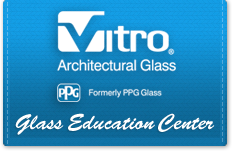
Glass is one of the most popular and versatile building materials used today, due in part to its constantly improving solar and thermal performance. One way this performance is achieved is through the use of passive and solar control low-e coatings. So, what is low-e glass? In this section, we provide you with an in-depth overview of coatings.
In order to understand coatings, it’s important to understand the solar energy spectrum or energy from the sun. Ultraviolet (UV) light, visible light and infrared (IR) light all occupy different parts of the solar spectrum – the differences between the three are determined by their wavelengths.
- Ultraviolet light, which is what causes interior materials such as fabrics and wall coverings to fade, has wavelengths of 310-380 nanometers when reporting glass performance.
- Visible light occupies the part of the spectrum between wavelengths from about 380-780 nanometers.
- Infrared light (or heat energy) is transmitted as heat into a building, and begins at wavelengths of 780 manometers. Solar infrared is commonly referred to as short-wave infrared energy,
- while heat radiating off of warm objects has higher wavelengths than the sun and referred to as long-wave infrared.
- There is a lot to know about glass performance in a sunroom or in any living space with glass windows and doors. The best and most reliable information comes from PPG which is a major glass manufacturer. Here is a video by PPG Glass education center with a detail explanation of “what is low e glass” Click here to see the educational video.

Comments are closed.